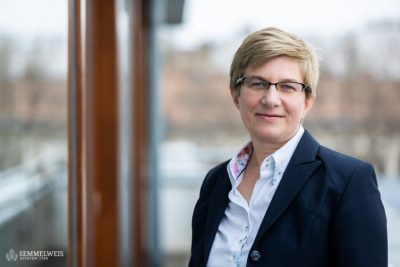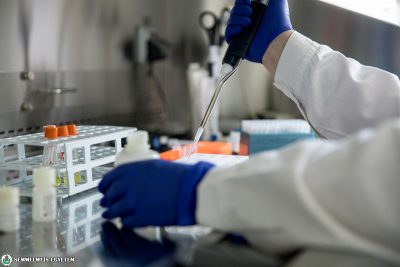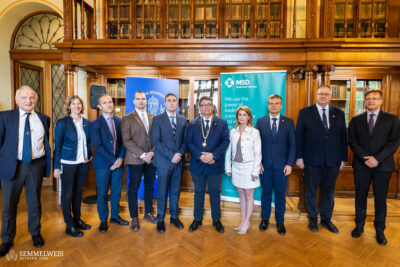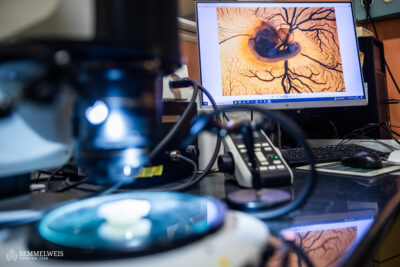It is in the common interest of the researchers, the university, and ultimately the country that each discovery is utilized outside the walls of the laboratory and serves patient care as soon as possible, pointed out Dr. Renáta Papp, Director of the Center of Science and Innovation Vice-Rector and Business Development (TÜK). It is no coincidence that increasing the utilization of RDI results, innovative developments in the market, as well as increasing the number of spin-off companies based on university intellectual properties were given particular emphasis in the rector’s program for the period of 2023 to 2028.
It is for this purpose that the university’s scheme for facilitating research, development, and innovation (RDI) has recently undergone a significant transformation. Established in mid last year, TÜK aims to give new impetus to the market utilization of the intellectual properties created at the university and to the support of spin-off enterprises, underlined Dr. Renáta Papp. TÜK, operating within the Rector’s Cabinet, has also taken over tasks related to intellectual property protection management from the Innovation Center, which was terminated in June last year, while the management of RDI grants is handled by the Grant Management Center, also headed by Vice-Rector for Science and Innovations Dr. Péter Ferdinandy.
 “Along with all of this, there has been a paradigm shift in the approach to the utilization of intellectual property. Accordingly, the utilization is both the goal and the guiding principle determining strategy and schedule, while the protection of intellectual property is an important milestone but not the end product. Instead of focusing our activity on obtaining as many patents as possible and concentrating on what we can be patented easily, our primary goal should rather be the utilization of the intellectual properties of our researchers. Naturally, one of the tools for this is intellectual property protection,” noted Dr. Renáta Papp.
“Along with all of this, there has been a paradigm shift in the approach to the utilization of intellectual property. Accordingly, the utilization is both the goal and the guiding principle determining strategy and schedule, while the protection of intellectual property is an important milestone but not the end product. Instead of focusing our activity on obtaining as many patents as possible and concentrating on what we can be patented easily, our primary goal should rather be the utilization of the intellectual properties of our researchers. Naturally, one of the tools for this is intellectual property protection,” noted Dr. Renáta Papp.
In order to increase the utilization of intellectual properties, Semmelweis University has a HUF 500 million (EUR 1,28 million) government subsidy available for the next three years within the framework of the public duty financing contract. This sum will also ensure that the university is able to provide the researchers with the most efficient assistance possible to utilize their discoveries from the very beginning, supported by additional funding and incubation services, so that they can be brought to the highest technological readiness level (TRL) in-house.
TRL, the life path of intellectual creations
 The TRL scale of 0 to 9 follows the life cycle of an intellectual property from the idea to the market-ready product. The discoveries made at the university are typically at TRL 1 to 2, i.e. there is an idea, an observed phenomenon, and a formulated concept. However, the goal is to get as many inventions as possible in-house and from internal resources to TRL 3 to 4 stage, that is, to reach tangible and successful experimental results and laboratory validation, which form the basis for effective utilization. This level, in the case of drug development, for example, can refer to a specific new drug candidate. In general, an invention may be utilized via sale, though this is less common, or, more frequently, through the so-called licensing, during which an external investor or a spin-off company established by the researcher helps its further progress. The degree to which the researcher and the university will benefit from the license fee is determined within the framework of the license contract, the guidelines of which are laid down in the university’s Intellectual Property Management Regulations.
The TRL scale of 0 to 9 follows the life cycle of an intellectual property from the idea to the market-ready product. The discoveries made at the university are typically at TRL 1 to 2, i.e. there is an idea, an observed phenomenon, and a formulated concept. However, the goal is to get as many inventions as possible in-house and from internal resources to TRL 3 to 4 stage, that is, to reach tangible and successful experimental results and laboratory validation, which form the basis for effective utilization. This level, in the case of drug development, for example, can refer to a specific new drug candidate. In general, an invention may be utilized via sale, though this is less common, or, more frequently, through the so-called licensing, during which an external investor or a spin-off company established by the researcher helps its further progress. The degree to which the researcher and the university will benefit from the license fee is determined within the framework of the license contract, the guidelines of which are laid down in the university’s Intellectual Property Management Regulations.
As the director highlighted, it is paramount during the entire process that the inventor is at the center of the support services provided by the university and coordinated by the business development managers, and that the university’s interests are also represented in the cooperation.
The innovation is best known by the person who designed it, and our task is to support its utilization as soon as possible with financial, regulatory, and marketing services that facilitate market entry.
Currently, innovation and research results that are potentially suitable for market utilization reach the TÜK after going through various procedures, e.g. screening of publications or abstracts in the case of the Students’ Scientific Conference (TDK) and PhD lectures, with the aim of determining whether it may be necessary to postpone the publication or, in the case of an abstract, whether it should be classified to avoid its novelty being potentially destroyed in the case of subsequent IP protection. At the same time, the researchers themselves can also contact TÜK at tto@semmelweis.hu.
The most common innovations with market utilization potential are medical devices, pharmaceutical patents, or new calculation methods, algorithms, other know-how, furthermore, special databases also represent significant potential.
The University Innovation Committee (EIB) is responsible for making decisions related to submitting, protecting, exercising and utilizing intellectual properties. The first step towards the market utilization of an intellectual property created at the university is therefore to bring the given discovery before the EIB, which then decides on the admission of the given project. The proposal necessary for this is compiled by TÜK, which, among many other things, must also include the possibilities and conditions of utilization.
Since its establishment in mid last year, TÜK has compiled 22 such decision preparation materials, managed 19 intellectual property protection procedures, and signed utilization contracts with two spin-off companies.
Pálma Dobozi
Translation: Mária Sánta
Photo: iStock; Bálint Barta – Semmelweis University



